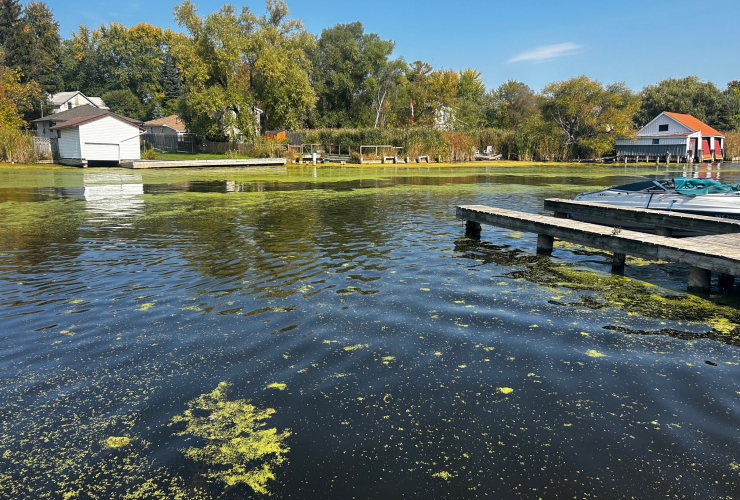Support journalism that lights the way through the climate crisis
Ontario announced over $1.3 million to help tackle persistent problems with high phosphorus levels in Lake Simcoe.
The announcement comes a month after Canada’s National Observer reported concerns raised by local advocates who assert that provincial efforts have fallen short of addressing the urgency of reducing phosphorus pollution. This reduction is deemed essential for safeguarding coldwater fish habitats and preventing excessive weed growth and algae blooms.
Phosphorus levels in Lake Simcoe are still at 90 tonnes per year, far higher than the crucial target of 44 tonnes per year by 2030 reduction goal set in the Lake Simcoe Protection Plan for 2023.
According to research, phosphorus plays a pivotal role as a vital nutrient for crops and is a key component of various fertilizers, including animal manure. While essential for plant growth, excess phosphorus can have detrimental effects on water quality near agricultural areas.
“It’s incredibly rewarding to know that our collective efforts are having a positive impact on the health of Lake Simcoe,” said Environment Minister Andrea Khanjin. “Our government knows that a healthy Lake Simcoe provides the foundation for healthy communities, healthy people and a healthy economy. That’s why we’re continuing to invest in projects and work with local leaders to further protect and restore the lake and its watershed.”
Led by the Lake Simcoe Region Conservation Authority and local partners, the four multi-year projects the money will help fund include: water sampling and analysis to monitor phosphorus and other nutrients flowing into Lake Simcoe; a study of harmful chemicals and metals in the water and sediment; the creation of wetlands and ponds; and stream restoration, channel building and planting of grasses to better manage stormwater in Innisfil, Newmarket and Oro-Medonte.
These projects will help landowners and municipalities lower the amount of pollution going into Lake Simcoe from urban areas, according to a statement from the ministry.
At least one local environmentalist was underwhelmed by Thursday’s announcement.
“We see no action plan that will result in lower phosphorus loads yet,” said Claire Malcolmson, executive director of the Rescue Lake Simcoe Coalition. “The province of Ontario has not yet met its obligation to update its Lake Simcoe Phosphorus Reduction Strategy. We need a detailed and serious plan to bring phosphorus loads down.”
Words and litter pickups will not save Lake Simcoe, she added.
The ministry insists the projects will help Lake Simcoe. There are already some positive signs of recovery in the watershed, including a 50 per cent reduction in phosphorus from sewage treatment plants, reduced algae levels in the lake and successful reproduction of coldwater fish like lake trout, lake whitefish, and cisco, the ministry added.
The ministry emphasized its commitment to the cause, noting that since 2018, it has invested over $27.3 million in Lake Simcoe protection and restoration. A $24-million investment was directed towards a phosphorus recycling project, specifically designed to reduce phosphorus discharges from the Holland River into Lake Simcoe, the ministry said.
Malcolmson told Canada's National Observer this money has only been committed, not spent and the state of the lake has not, in fact, improved substantially.
“We will celebrate those phosphorus reductions when we see them,” said Malcolmson. “To the contrary, salt levels continue to rise, the coldwater fishery continues to flounder [and] wetland protection has been weakened, which will lead to a loss of vital wetlands and habitat.”
The province continues to underreport the significant existing and looming threats to the lake while overplaying any gains, said Malcolmson. This is bad science, it is irresponsible and is not saving Lake Simcoe, she added.
Located about 70 kilometres north of Toronto, Lake Simcoe’s watershed, which sweeps across 3,400 square kilometres and 20 municipal borders, holds historical importance for the province.
Jonathan Scott, councillor for Ward 2 in the Town of Bradford West Gwillimbury said any funding for the lake is welcomed, and these projects have merit, but the government needs to act with urgency. “The tasks before us are clear: We’d like to see the Lake Simcoe Protection Plan updated to reduce phosphorus to 44 tonnes, the promised phosphorus recycling facility move forward and naturalized projects proposed by Bradford to clean up the Holland River funded.”
According to the ministry, phosphorus enters the lake through point sources like sewage treatment plants and diffuse sources from urban and rural areas due to everyday land use practices. While some diffuse phosphorus loading is natural, individuals and businesses can play a role in better managing a significant portion of it in the watershed, the ministry added.
According to the Lake Simcoe Region Conservation Authority, individuals can play a role in reducing phosphorus in stormwater runoff by using phosphate-free products, directing excess water to lawns and gardens and practising responsible car washing. Using native plants and phosphate-free fertilizers also helps reduce phosphorus inputs.
This story was produced in partnership with Journalists for Human Rights for the Afghan Journalists-in-Residence program funded by the Meta Journalism Project.
Typical Doug Ford government,
Typical Doug Ford government, another announcement, throw some money in, but present yet another no-plan at us. Ford sure is good with announcements that never have a real plan or substance behind them. How do you toss money at something without a plan or understand the problem and the real costs to remedy the issue?
Actually the annouced funds
Actually the annouced funds are a) earmarked, not spent, and b) 2 or 3 of the 4 projects are monitoring, which is necessary to assess progress but don't change anything.
The spin is typical for most organizations: a) deflect criticism by listing what they are doing (and not addressing whether their actions are adequate) and b) take credit for budgeted funds as if it is action and pushing the spending out over several years (often with most of the spending near the end).
If the Ford government has a (relatively) unique M.O., it is to stop monitoring and oversight so they save money in the short term and can seem to respond to the public when they re-instate monitoring as (perfectly foreseeable) problems arise. Destroying citizens' health and quality of life in the name of reduced bureaucracy.
well said. the clean up of
well said. the clean up of holland river,( currently a sewer for intense veg farming with pesticide nitrogen phosphorous run off very high, )by having set backs from water and planting reeds,etc in a ten meter swath by the watercourses would help!
NDP made that move in the 90 s and Harris cancelled it if course, in the name of fighting red tape. so cattle pooping in drinking water and we got…. Walkerton! how many folks still living with the terrible helth consequences of that tory “treat” of less red tape ( aka impunity to pollute?)






Comments